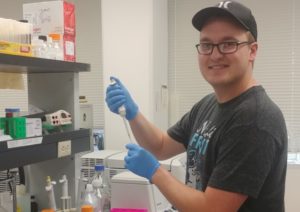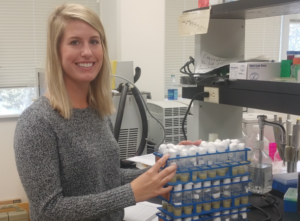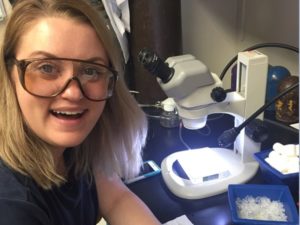My research interests are in the evolutionary genetics of host/pathogen interactions. I am particularly interested in understanding how pathogen genetics and virulence change following host shifts to permit a successful long-term infection of the novel host.
My lab studies host/pathogen interactions. We use Drosophila and Drosophila-specific viruses in a model system to learn about the evolution of virulence (harm to the host) following host shifts by studying the genetics of the pathogen and pathogenesis in the host. We want to understand why pathogens are capable of moving across host species (e.g., pigs to humans in swine flu).
A second line of research in the lab focuses on applied biotechnology. We aim to engineer microbes to produce beneficial products.
| Graduate Students | Projects | Update |
|---|---|---|
 | Jonah Frago Thesis Title: Investigating the Production Challenges of the P100.1 Phage Endolysin Abstract: Acne vulgaris is one of the most common skin diseases globally. One key aspect of acne pathogenesis is the disturbance of healthy strain diversity of the skin bacterium Cutibacterium acnes. Many acne treatments are antimicrobial; however, these treatments are generally non-specific and carry a variety of side effects in addition to contributing to rising antibiotic resistance. Lytic bacteriophages (or phages) are viruses that infect and kill bacteria. Their lytic lifestyle is facilitated by enzymes called endolysins. Phages have been studied as an alternative to traditional antimicrobials in acne treatment and have shown reduced C. acnes load in acne lesions and improved symptoms in patients. However, most current research uses intact phages. This provides logistical challenges as the phages must be cultured, maintained, and kept viable until treatment. Here, we sought to recombinantly produce and extracellularly secrete the P100.1 phage endolysin in a Lactococcus lactis production system. However, throughout this process, we encountered several critical roadblocks and were ultimately unable to achieve recombinant production. We attempted production in three expression plasmids, one of which being was chimerically produced. In the absence of results testing the antimicrobial effects of the recombinant endolysin, here we will discuss and investigate the challenges and impediments we faced during this project. We will discuss attempts with various cloning techniques, chimeric vector design and production, and the exhaustive efforts undertaken in our attempt to achieve production. | Jonah is currently working as a research technician at WSU Spokane. |
 | Kathryn Collins Thesis Title: Production and characterization of a phage endolysin with putative antimicrobial activity against Cutibacterium acnes Abstract Acne vulgaris (acne) is the eighth most common skin disorder worldwide. Because of the heterogeneous pathology of acne and the increasing antibiotic resistance of the causal agent (Cutibacterium acnes), novel therapeutics need to be developed to treat acne. One option is endolysins, highly conserved enzymes from bacteriophages that disrupt the bacterial cell wall. Endolysins retain bactericidal and bacteriostatic activity when applied to bacteria in vitro and are safe for topical application. We hypothesize that the endolysin (ENDL) from the P100.1 C. acnes bacteriophage will exhibit bacteriostatic activity against C. acnes in vitro. This study aims to bioinformatically characterize the P100.1 endolysin’s structure, produce and isolate the endolysin, then evaluate putative antimicrobial effects. We cloned the endolysin gene into vectors (pET11a & pBAD-GFP) for expression by Escherichia coli or as a fusion protein to green fluorescent protein (GFP). We compared the growth rates of C. acnes treated with cell lysate of cultures induced to produce the endolysin to non-treatment controls to evaluate bactericidal effects. We found >88% sequence similarity between endolysins of phages targeting C. acnes, indicating high conservation and that all currently identified endolysins of phages targeting C. acnes are amidases. Expression of the recombinant proteins could only be detected for the strains containing the pBAD-GFP vector and not the pET11a vector. The antimicrobial activity of endolysin-fusion protein was inconclusive, as the impact on the growth of C. acnes over time was negligible. Therefore, more research is needed to determine whether the P100.1 endolysin or other endolysins from C. acnes phages are viable anti-bacterial therapies. | Kathryn is currently working at Absci as a Research Associate 2 in Protein Engineering and Structural Biology in Portland, Or. |
 | Taylor Mauzy Thesis Title: Developing a vector for expressing serratiopeptidase in Lactococcus lactis Abstract Chronic inflammation stems from the inability of the body to resolve acute inflammation. Chronic inflammation is a growing health concern, as nearly 60% of Americans reported coping with at least one chronic condition (as of 2014). On a world scale, three fifths of deaths result from a chronic inflammation disease. Treatments for chronic inflammation include lifestyle changes (diet and exercise) and a variety of conventional drugs. Beyond these treatments, supplementing the body with systemic enzymes may attenuate inflammation. One promising enzyme is serratiopeptidase. Serratiopeptidase is a serine protease expressed by Serratia marcescens which has demonstrated anti-inflammatory, anti-edemic, and analgesic activity in laboratory studies and pre-clinical trials. Clinical trial data is less convincing, likely because the enzyme delivered is not bioavailable to the body after it passes through the stomach. To circumvent this issue, we proposed developing a plasmid vector that, when transformed into the probiotic Lactococcus lactis, would allow for bioactive serratiopeptidase production within the gut; thus, increasing bioavailability. The vector designed was delivered from the synthesis company in two fragments (they failed to assemble to full vector). After successfully, assembling the vector, the selection system in the commercial L. lactis strain we chose did not work as advertised in our hands. We introduced antibiotic resistance into the vector to facilitate the selection process after transformation. Unfortunately, the vector with antibiotic failed to transform L. lactis indicating some unknown problem with the vector / host system. | Taylor is currently working as a Research and Development Scientist at Silgan Unicep in Spokane, WA. |
 | Katie Johnson Thesis Title: Virulence of Drosophila C virus increased after a host shift and serial passage in Drosophila hosts Abstract The outcomes of novel host-pathogen interactions are unpredictable but can result in epidemics or pandemics. Exploring the initial encounter between a pathogen and a novel host species can elucidate why some pathogens successfully infect and adapt on a novel host when others fail. Much of our understanding of host virulence after host shifts was developed using serial passage experiments (SPEs) in bacteria. Three accepted SPE generalities have emerged: virulence increases on the novel host, the evolved pathogen will become less able to infect its native host, and the pathogen experiences convergent evolution. This study tests the first two generalities using complex hosts (Drosophila sp) and the highly virulent Drosophila C virus (DCV). The fitness of DCV was utilized as a proxy for virulence (pathogen’s harm to host) and investigated over 10 serial passages of the pathogen. The number of eggs, pupae, and adults were measured along with the days to pupation and to adulthood. We observed significant decreases in fecundity for both hosts but no significant effects on developmental metrics. The novel host experienced a significantly larger decrease in survivability than the native host. This decrease in fecundity and increases in mortality indicate an increase in DCV virulence on the novel host. Viral load does not explain the increase in virulence. The virus evolved on the native host was equally virulent to the native host as the ancestral virus, in contrast to SPE predictions. This study supports the SPE generality of increased virulence in the novel host even with a physiologically complex host and a highly virulent pathogen. | After completing her Ph.D. at the University of Georgia, Katie is currently a Postdoctoral researchers at the Universitee Paris-Saclay in Paris, France. |
 | Steven A. Smith Thesis Title: Identification of genes from the poxvirus of a parasitoid wasp Thesis Abstract: The Diachasmimorpha longicaudata entomopoxvirus (DlEPV) is a presently unclassified, insect-specific poxvirus. The virus was first identified in the accessory poison gland apparatus of a female parasitoid wasp, D. longicaudata. The wasp apparently injects DlEPV into host fly larvae along with the egg during oviposition. Although the effect of the presence of DlEPV on wasp larvae survival within the host is unknown, the virus does appear to disrupt haemocyte encapsulation response. The DlEPV genome has not yet been fully characterized. A total of nineteen genes have been identified (10 of known functions, 9 of unknown) and the expected genome size is 290—300 kilobase pairs (kbp). We subjected DlEPV DNA to sequencing and structural analysis. We found all 19 known DlEPV genes, identified an additional 48 DlEPV genes; thus more than doubling the number of know DlEPV genes. DlEPV open reading frames (ORFs) were found to have significant homology to both essential and nonessential poxvirus genes. We also report the presence of a putative NAD+-dependent DNA ligase, only the second example of this gene from a virus. DlEPV clearly is a poxvirus. However, it likely needs to be classified into its own genus as it is quite different to other EPVs. | Steven is currently a project manager at the OHSU Knight Cancer Institute. |
 | Emily K. Hendrix Thesis Title: Characterizing the early stages of a novel host shift using host fitness and metabolomics Thesis Abstract: The factors that contribute to successful colonization of a novel host species by a pathogen remain unclear. One likely factor determining host shift success is the early interaction between host and pathogen at the very moment of the host shift event. How does a novel host respond to a pathogen insult immediately following infection? To answer this question, the Drosophila model was used along with the highly pathogenic Drosophila C virus, host fitness assays and metabolomic analysis to measure the host’s response to a novel pathogenic infection. As Wolbachia can interfere with RNA virus infection success, a new method was developed to reliably and quickly eliminate Wolbachia from the flies. Once the flied were confirmed to be Wolbachia-free, they were injected with DCV. Females of the native host (D. melanogaster) and the novel host (D. mauritiana) were injected with DCV or Schneider’s media, subjected to fitness tests, frozen in liquid nitrogen and their metabolomes were analyzed. The novel host had equal or increased fitness (fecundity, hatchability, pupation, number of pupae, and number of adults), but significantly higher mortality. Metabolomic analysis revealed that many metabolites from a variety of metabolic pathways were significantly different. A wide range of stress-related metabolites were upregulated in the native host, but not in the novel host. These results support the hypothesis that the initial physiological interaction between a pathogen and its novel host is critical for the survival of the host or the success of the pathogen. | Emily is currently a Ph.D. candidate at the University of Texas Medical Branch. |

